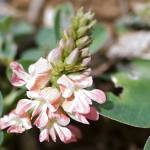Creeping Indigo: A Dangerous Weed for Horses

Can any landowner honestly boast of a weed-free pasture? Hardly! Even the most beautifully maintained pastures and paddocks contain weeds and, as horsemen know, some weeds are more sinister than others. In Florida and adjacent states, increased recognition of creeping indigo in pastures and an uptick in cases of toxicity have researchers on high alert.*
The stems and leaves of creeping indigo lie just above the ground. Plants contain five or seven leaves per stem, and pink flowers form at the base of the leaves. Seeds are contained in clustered needlelike pods. Because of its low-growing nature, creeping indigo is often overlooked by casual observers, but is easily identified by well-trained individuals.
Over the last decade, outbreaks of creeping indigo toxicity have occurred in various parts of Florida, including Marion County, home to a dense population of horses, especially in winter. The disease was once called “grove poisoning” among Floridians due to the belief that it was caused by pesticides used in the citrus industry. Similar disease has been observed in other parts of the world, including in Australia, where it is sometimes referred to as “Birdsville horse disease.”**
Horses with creeping indigo toxicity may appear quieter than usual, but this usually segues into depression, lethargy, neurological problems, and recumbency. More obvious neurological signs include head-pressing, compulsive walking, head-tilting, reduced blink response, incoordination and weakness in all limbs, instability of joints during weight-bearing, and unusual gaits that have been described as “crablike” and “goose-stepping.” Many horses are unable to rise after lying down.
Nonneurological signs include weight loss, poor appetite, elevated heart and respiratory rates, dehydration, light sensitivity, corneal opacity and ulceration, tongue and gum ulceration, and abnormal digital pulses without other indications of laminitis.
Two toxins play a role in creeping indigo poisoning: 3-nitropropionate (3-NPA) and indospicine.
Plants produce 3-NPA as a defense mechanism against herbivores. The toxin is a potent inhibitor of a key enzyme that transforms glucose and oxygen into usable energy. Nerve cells are extremely sensitive to energy deprivation, which likely causes the characteristic neurologic signs of the disease. Indospicine is a nonprotein amino acid that is toxic to the liver because of antagonism to the essential amino acid arginine, with which it competes. One of its principal toxic actions is inhibition of nitric oxide synthase, which likely explains the development of corneal disease and ulceration of mucous membranes.
Researchers from the University of Florida recently reported on an incident of suspected creeping indigo toxicity in Marion County affecting horses recently moved from Maryland.* Presumptive evidence strongly buttressed the diagnosis of creeping indigo toxicity in these cases because: (1) creeping indigo was widely present in grazing areas, (2) development of progressive neurological disease with concomitant ocular and oral mucosal abnormalities, (3) normal or nonspecific aberrations in hematological and blood chemistry analyses, and (4) exclusion of other diagnostic possibilities based on history and physical examination.
The same research team conducted a trial to quantify the putative toxins by feeding five ponies dried, chopped creeping indigo in an amount thought to induce toxicosis. Other than weight loss and increased plasma protein concentration, no other clinical or laboratory signs of creeping indigo toxicity were observed.
Horses with suspected toxicity should be removed from any pasture or paddock containing creeping indigo and should receive immediate supportive therapy from a veterinarian. Nutritional support may include targeted supplementation of nanodispersed natural-source vitamin E, such as Nano-E. Horses diagnosed quickly often recover entirely with no lasting effects, though gait abnormalities occasionally persist.
Pasture management includes renovating pasture to achieve a high-quality stand of forage in an effort to outcompete creeping indigo and other weeds, limiting stocking rate to avoid overgrazing, applying appropriate fertilization based on soil samples, and using suitable herbicides conscientiously. An expert in pasture management can provide specific recommendations.
*Darby, S., L.C. Sanchez, M.F. Mallicoter, A.M. House, C.E. Plummer, V. Nadruz, R.H. Benmoha, S.M. Roberts, H. Derendorf, C. Silva-Sanchez, J. Claire, and R.J. Mackay. 2022. Plasma l-indospicine and 3-nitroproprionic acid in ponies fed creeping indigo: Comparison with results from an episode of presumptive creeping indigo toxicosis. Equine Veterinary Journal 54:145-152.
**Ossedryver, S.M., G.I. Baldwin, B.M. Stone, R.A. Mackenzie, A.W. van Eps, S. Murray, and M.T. Fletcher. 2013. Indigofera spicata (creeping indigo) poisoning of three ponies. Australian Veterinary Journal 91:143-149.








